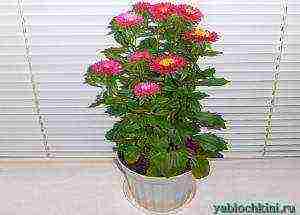Content
Table of contents:
- Growing silver acacia (yellow mimosa)
- How to grow bashful mimosa
Mimosa is a genus of flowering leguminous plants. In the world, the most famous bashful mimosa, but in Russia, mimosa is mistakenly called a completely different plant - silver acacia or whitewashed acacia, which is a member of the acacia genus of the same family. Below, when describing how to grow mimosa at home, silver acacia will be included as well.
Growing silver acacia (yellow mimosa)
At home in Australia, the silver acacia is a huge tree that grows up to 45 m, and in other places - usually up to 10-12 m. But it is quite possible to grow mimosa at home in the form of one and a half meter bushes from its seeds.
Growing from seeds
 If you plan to grow mimosa from seeds at home, then you need to plant them in January-March. In order for the seeds to germinate, they need to be soaked in hot (60 degrees) water, and then kept for another two days in warm (40 degrees) water. Some growers recommend dousing them with boiling water instead and slightly cutting into their tough skin.
If you plan to grow mimosa from seeds at home, then you need to plant them in January-March. In order for the seeds to germinate, they need to be soaked in hot (60 degrees) water, and then kept for another two days in warm (40 degrees) water. Some growers recommend dousing them with boiling water instead and slightly cutting into their tough skin.
A pot for sowing mimosa in diameter should not exceed 15 cm, and as the plant grows, every 2-3 years it is necessary to increase the diameter of the pot by 3-4 cm, until it reaches 60 cm.The soil for silver acacia needs slightly acidic or neutral. To cook it yourself, you need to take:
- one part of sand;
- three parts of light turf soil;
- two pieces of peat.
Mix the ingredients well and pour over. For seed germination, you need at least 25 degrees of heat, so it is better to put the pot not on the windowsill, but on the shelf next to the heating radiator, remembering to maintain the humidity of about 60%. Mimosa grown from seeds at home is capable of blooming in the second or third year.
Growing from cuttings
This task is somewhat easier to solve. In the second half of summer, cuttings 5-10 cm long should be cut off from an adult plant. Suitable offspring often grow at the base of the tree trunk, and, having cut them off with a sharp knife, can be further used as cuttings.
- Plant the stalk in a small pot filled with a mixture of sand and peat (1: 1) and cover with the cut-off bottom of a plastic bottle.
- During the entire rooting period (two to three months), the soil must remain moist.
Video about mimosa (silver acacia)
Mimosa (silver acacia) care
Caring for mimosa at home involves moving it to a bright, warm place, since acacia is very fond of the bright sun. In the summer, it is advisable to put it out on the street. In winter, when the plant is resting, it should create cool conditions (but not less than 10 degrees). From spring to autumn, the plant must be watered abundantly, and in winter - moderately, without overmoistening the earthen coma. Every spring and summer, the plant should be fed with liquid complex fertilizers, and during the March flowering period, it should be fertilized every two weeks. The higher the temperature in winter, the earlier the acacia will bloom. Immediately after flowering, it must be cut off, leaving only the shoots located near the trunk, and the trunk must be shortened.
How to grow bashful mimosa
Under natural conditions, this true mimosa grows in the tropics of South America, bush 0.5-0.7 meters. What a bashful mimosa looks like at home in the photo - not everyone has seen it, although this annual flowering plant is often found in greenhouses, at home it is called a vampire plant.
Bashful mimosa also propagates by cuttings or seeds. The plant has lilac-pink spherical flowers with a diameter of 2 cm, they grow at the ends of the shoots in summer. This moisture-loving plant does not like drafts.
Caring for bashful mimosa
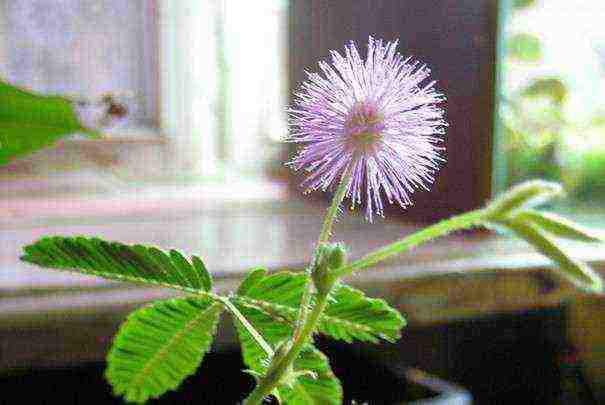 For bashful mimosa, a substrate made up of equal shares is suitable:
For bashful mimosa, a substrate made up of equal shares is suitable:
- turf land;
- peat;
- humus;
- sand;
- leavening agents can be polystyrene and coarse perlite.
It is useful to add bone meal to the soil for nutritional value. Top dressing can be done with complex fertilizers used for flowering plants. In order for the bashful mimosa to be able to tie seed pods, self-pollination will be required with a cotton swab or brush, which transfers pollen from the stamens to the pistils of neighboring flowers. Pollinated flowers form a pod that contains seeds. The ripe and dried pod must be removed and put into a signed paper envelope until spring.
In the spring, you need to remove the seeds from the pod, soak and then plant in the ground. The seeds resemble lentils with a glossy, dense skin. It is better to sow these seeds in grooves in loose soil in early spring, and when two true leaves hatch, the sprouts can be planted. In order for the bashful mimosa seeds to germinate, the room must be very warm (20-26 degrees). Moisten the soil after planting and cover with a jar to create a greenhouse effect. Sowing is carried out superficially, you can simply sprinkle the seeds with five millimeters of a fine substrate. After sowing, it is better to press the seeds to the ground, achieving close contact. After a week, sprouts appear. Mimosa requires light, heat and high (80%) humidity at the beginning of development. At the same time, the soil must not be waterlogged, so as not to provoke the appearance of a black leg. This requires sterile soil and good drainage. The soil can be sterilized with a weak solution of potassium permanganate.
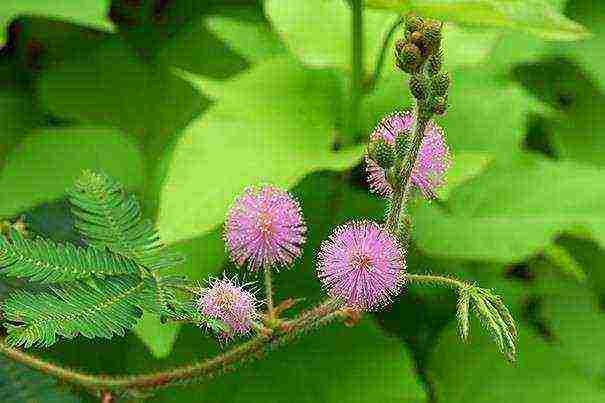 Anyone who knows how to care for mimosa at home will put a pot with it under natural light on the east or west side, because mimosa must be protected from intense sun rays to avoid burns.
Anyone who knows how to care for mimosa at home will put a pot with it under natural light on the east or west side, because mimosa must be protected from intense sun rays to avoid burns.
When the seedlings reach a height of 5 centimeters, you can accustom them to the open atmosphere of a balcony, loggia or street.
Seedlings do not tolerate drought and may respond to it by discarding foliage.
In addition to systematic watering, the plant can be amused by spraying with warm water. Shy mimosa grows slowly. It has a reddish stem. This plant has a rare quality - if you touch its leaf, then its feathery plumage will quickly fold along the axial vein, and the leaf stalk will drop, as if drooping. In the same way, this plant reacts to the sunset, but in the morning it wakes up and completely straightens up.
Have you tried growing mimosa at home? Did you succeed? Let us know in the comments.
Video about growing bashful mimosa at home
 Shy mimosa is an amazing houseplant. Any touch makes its delicate leaves curl, hence the name. This is not the same flower that is associated with the 8th of March, but it is also beautiful and valuable among plant breeders in its own way. Shy mimosa seeds are available commercially. Florists share their experience on how to organize the cultivation of this unusual plant on the windowsill.
Shy mimosa is an amazing houseplant. Any touch makes its delicate leaves curl, hence the name. This is not the same flower that is associated with the 8th of March, but it is also beautiful and valuable among plant breeders in its own way. Shy mimosa seeds are available commercially. Florists share their experience on how to organize the cultivation of this unusual plant on the windowsill.
Description and characteristics of mimosa
In the wild, this herbaceous crop grows in the hot tropics of America, Africa and Asia. At home, this mimosa looks more like a shrub and can even grow up to 1.5 m, although usually lower. The plant has the following characteristics:
- erect stem with small thorns;
- there are leaves on the stem - 3-5 two-pinnate groups, which diverge in different directions;
- flowers with a diameter of no more than 2 cm are formed at the tops of the shoots;
- flower shape - rounded;
- color - pink-lilac shades.
Attention! The leaves of the plant are folded at night or even with a light touch. But it is not advisable to play with them - this negatively affects the health of the mimosa.
In a room setting, mimosa is grown as an annual. Reproduction is carried out every year by cuttings or seeds. However, the shoots are extremely difficult to root. Mimosa pollen is very fine. Often people with corresponding allergies react painfully to it.

Shy mimosa flowers
Features of growing room mimosa from seeds
To get a full-fledged plant, it doesn't matter if you bought seeds or collected them yourself from a fertilized flower. Pollination of mimosa should be scrupulous. There are 2 possible ways:
- Arm yourself with a brush. Use this tool to transfer the dust particles to another flower.
- Rub the mimosa inflorescences together a little.
Attention! An external sign of successful fertilization in the photo and in person is the formation of an ovary and a thickening of the tip of the stem.
After a while, a seed pod is formed. Each of these grows 6-10 pieces of mimosa seeds. The fruit can be picked when it is completely dry:
- without opening, wrap the pod in plastic;
- place in a refrigerator at + 5 ° C and store in this state until spring;
- in March, remove and open the fruit. Inside there will be dark pea seeds with a diameter of about 2 mm;
- they need to be sown shortly after removal from the cold;
- before planting, place the material in warm water for half an hour in order to further accelerate the emergence of seedlings.

Sowing bashful mimosa is carried out in a steamed peat substrate with an admixture of sand or in a universal soil from a store. The structure of the soil should be loose and light. A large container is not needed - find narrow bowls with a hole in the bottom. Before filling the container with a substrate, lay out an expanded clay layer for drainage.
Attention! Any soil for mimosa must be disinfected. The plant is capricious in this regard.
Sowing step by step goes like this:
- Moisten the soil well. Drain off excess moisture.
- Spread the seeds on the surface, followed by dusting with a thin layer of the same soil, or deepen by 1 cm.
- Cover crops with foil to keep warm and moisture at a constant level.
Care of mimosa seedlings
The humidity under the mini-greenhouse film must always remain high. Temperature norm - + 25 ... 30 ° С. Seedlings should be ventilated once a day. When you remove the protection, water with a sprayer to prevent the water from carrying seeds to the surface.
Under good conditions, seedlings can be expected in 2-4 weeks. After that, transfer the bowls to a sufficiently lit place, without abundant sun. The film can be removed. Humidity should be reduced to avoid extremes. But the temperature will need to be the same as before the emergence of shoots.
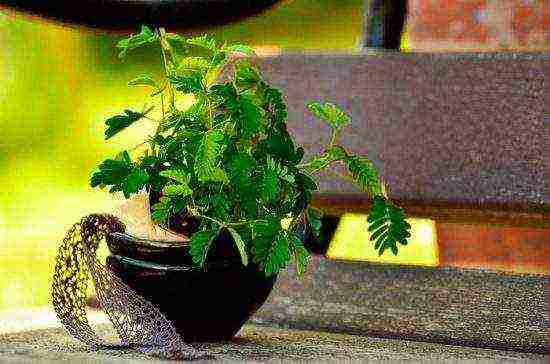
After the appearance of 3 real leaves, the seedlings are ready for picking. Prepare a separate small pot for each. Place a drainage layer on the bottom. Fill the container with a mixture of peat, turf and leafy soil and sand (all in equal parts). Pots should also not be placed in direct sunlight.
Attention! Transferring seedlings should be extremely careful because of the fragile roots.
Features of growing bashful mimosa
In order for the culture to grow without problems, in the process of leaving, try to take into account the following features of it:
- An adult plant loves the sun, so it is better to place it on a southern windowsill. In hot climates, adjust towards neighboring cardinal points. In the shade, mimosa will stretch out and lose its beauty. But even on the south side of the midday sun, the flower should be shaded.
- Maintain t + 22 ... + 24 ° С from March to October. The rest of the time - about +17 ° С.
- The optimum moisture content for mimosa is at least 70%. Spraying or placing the pot in a pan of damp material helps to maintain it.
- During the active growing season, water once every 2 days. The norm is the wet state of the topsoil.In winter, the water volume should be reduced. Use soft filtered water.
- If, when watering or spraying, drops fall on the leaves, they can burn them.
- Twice a month in a warm season, the flower needs to be fed with mineral fertilizer complexes.
Proper care will give you a beautiful flowering of mimosa, which lasts from June for about 4 months. During this period, it is important that the indoor air is clean.
Shy mimosa: video
Can mimosa be grown from a branch? How to grow mimosa from a branch?
-
That mimosa, with yellow balls, which we used to receive on March 8, is actually called silver acacia. As a rule, such acacia is grown from seeds. However, with a strong desire, it can also be grown from a branch, because acacia propagates by cuttings. First, you need to wait until the presented branch of mimosa blooms. The top that has faded and the side branches, as well as the leaves, must be cut off. Before rooting, the resulting cuttings can be dipped into a solution of special stimulants for 8 hours. The softest effect will be exerted by such stimulants as quot; Zirconquot; or quot; Ribav-Extraquot;. Next, the plant can be planted in a small flower pot for rooting. The soil for planting should contain sand and peat, or charcoal. It remains to cover the stalk with a transparent bag, a plastic bottle with a cut off neck, or a plastic cup and wait. Mimosa takes root for a long time - about 2, or even 3 months. All this time, you need to water it regularly so that it does not dry out. Be sure to also place the pot in a warm, lit place. When the plant grows, it can be transplanted into a larger pot. From spring to summer, silver acacia needs to be watered abundantly enough, in winter more moderately, but do not bring it to dryness. Acacia loves well-lit places, the optimal temperature in summer for it is about 24 degrees Celsius. She does not like frost, but in winter she requires a cooler temperature. It can withstand up to - 10 degrees.
-
I want to say right away that the mimosa, to which we are all accustomed, is actually a silvery acacia and has nothing to do with bashful mimosa. Why bashful? Because she is known for folding her leaves when touched. The homeland of mimosa is the southeast coast of Australia, as well as the island of Tasmania, and in Russia, mimosa grows well near the Black Sea.
It is really possible to grow our mimosa from a branch. You can cut cuttings directly from the presented bouquet. The main thing is to choose fresh mimosa.
Mimosa bashful native to the southern subtropical regions of America. Its natural habitat is its homeland and Brazil. This genus has more than 500 species. One of them is the "bashful" mimosa, or, as it is called, "touchy", which is grown at home. This plant got its name for the ability of the leaves to fold and fall down at the slightest mechanical impact, as if embarrassed by something.
Description of the species
Bashful mimosa at home is an annual, beautifully flowering herbaceous dwarf shrub. It is an evergreen plant 30-40 cm high. Branched stems are very light. They are covered with spines resembling fine hairs. Numerous leaves of light green, double-pinnate leaves are always twisted and lowered at night, and during the day - only when exposed to them. After a certain time, at rest, the leaves unfold.
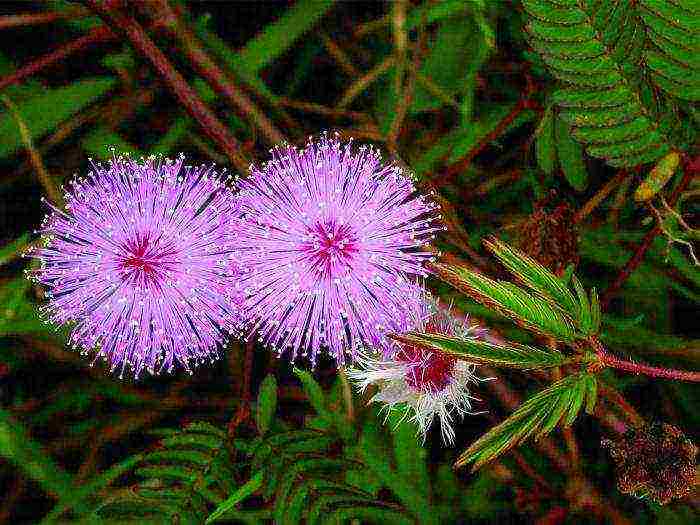
A delicate plant is bashful mimosa. The flowers are pink or lilac in color. They are collected in small fluffy spherical heads. Bloom for 2-3 days and fall off. The fruits are formed on the ovaries during self-pollination of the plant and look like beans. They are not used for food, their poison can be poisoned. The flowering period is long in time: it begins in the summer and ends in the fall.Sometimes mimosa is confused with silver acacia, which represents the Mimosa family, but is not a plant of that name. The main difference is that its flowers are yellow.
Growing
Mimosa bashful at home prefers lighted places. She does not like wind, drafts and odors, especially tobacco smoke. In a smoky room, its leaves curl up and fall off. The best temperature for her in summer is 20-25 degrees, and in winter 16 is enough. The shrub loves moisture, but in moderation. In the spring and summer periods, it should be watered regularly and abundantly; in extreme heat, sprinkle irrigation. And in winter, when the plant is resting, it is enough to monitor the condition of the soil and prevent it from drying out. Water as needed. Waterlogging can lead to a loss of decorative effect. On loose fertilized soil, bashful mimosa grows better. Growing from seeds makes it possible to get many shrubs at the same time.
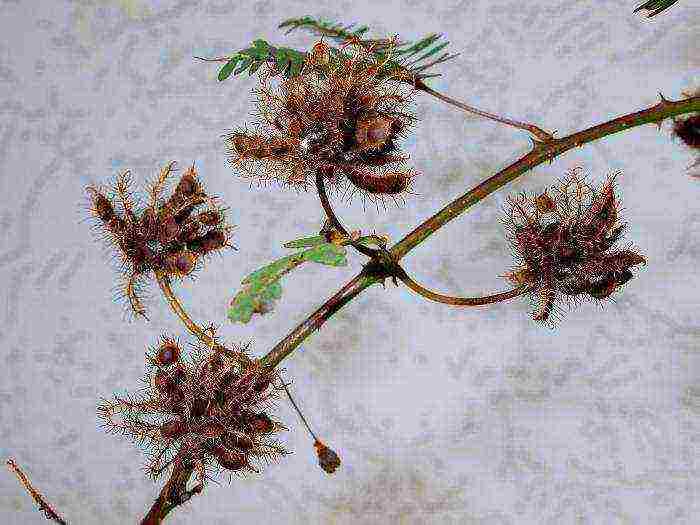
For fruit to set, the plant must be pollinated. This process can be done by yourself. It is enough to transfer pollen with a brush or soft swab. After that, a pod begins to form. When it is ripe and dry, it is ripped off and placed in a paper bag. The pod will be stored in it throughout the winter, until the onset of spring. It is important to remember that this plant is difficult to preserve in winter, it dies.
Transfer
Mimosa bashful at home grows like an annual, it does not need to be transplanted. If necessary, this is done in the following cases:
- When the shrub is left for the winter and grown as a perennial.
- If the "touchy" gets sick, or the soil starts to rot.

The transplant should be done by the transshipment method. In a larger pot, the plant is placed along with a clod of earth. First, the bottom of the pot is covered with pebbles, which will act as drainage. The soil is prepared in advance. The earth is mixed with sand, peat and decayed foliage. It is better to replant the shrub early in the morning or in the evening, when the sun goes down.
Reproduction
Bashful mimosa from seeds may well grow, but they need to be planted exclusively in March and April. Their shape resembles beans or peas squeezed from the sides, the rind of which is very dense and has a glossy sheen. For germination, you need to take a saucepan, pour soil into it and lay out the seeds, without sprinkling it with earth. You can press down a little for better contact with the soil. Then the future bashful mimosa is poured with hot water. The seeds will start to crackle, this is normal. Cover the pan with a lid on top. This will maintain the required humidity in it. After a while, the beans will sprout. The bashful mimosa sprouts will give friendly sprouts. Growing from seeds is business troublesome, but worth it.
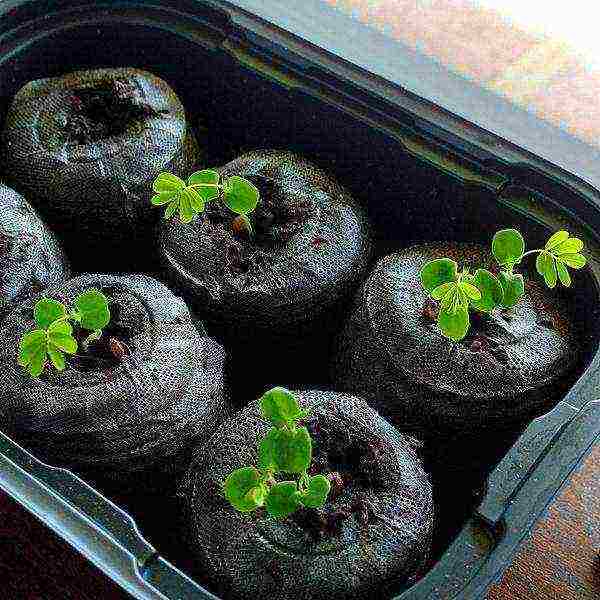
Sprouted beans are planted in well-loosened soil. Seedlings will appear in a week. When they grow to the size of a few leaves, they can be transplanted into separate pots with good drainage and sterile soil. To destroy bacteria, it is enough to spill it with a solution of potassium permanganate.
When and how to feed mimosa?
"Impatient", like any plant, needs nutrients. She receives them during feeding. It is carried out when the shrub is actively growing. In spring and until mid-summer, bashful indoor mimosa is fed with nitrogen, potassium and phosphorus. These fertilizers are mixed in equal proportions and applied to the soil twice a month. In the second half of summer and before the beginning of autumn, buds are formed. Therefore, phosphorus and potassium are needed in large quantities. To make the soil more nutritious, bone meal should be added to it. Feeding can be done with complex mixtures for home flowers. In autumn, the growth of shoots stops. At this time, the application of all fertilizers is stopped. If this is not done, the bashful mimosa will not rest and may weaken.Growing a houseplant will not bring pleasure, as the shrub will lose its decorative effect.
Beneficial features
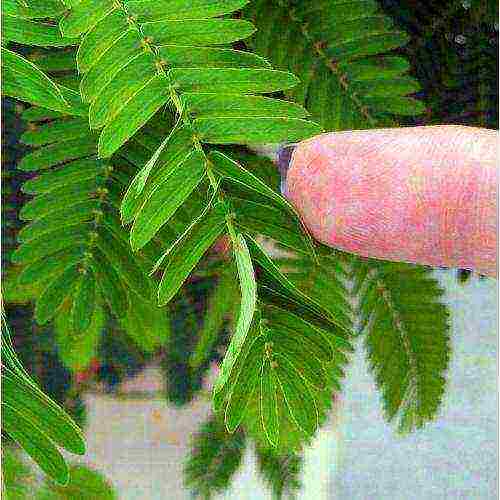
"Impatient" is known for its beneficial properties. It has long been used in many European countries in medicine. Non-traditional methods of treatment are not complete without the use of the healing properties of this plant.
- Tincture of leaves cures sore throat, lowers fever.
- Bark decoction - dysentery and headache.
- Ointments heal burns and heal wounds.
- Mimosa preparations purify the blood.
- They help in the treatment of the heart and nervous system.
- They tidy up the liver and gallbladder.
What is sick and who is damaged by mimosa?
- If the shrub experiences excess moisture, its leaves will turn yellow and begin to curl up during the day.
- When the plant grows in a room where tobacco smoke is always present, it sheds foliage.

- Falling leaves are also associated with irregular watering.
- With a lack of lighting and low air temperatures, the bashful mimosa feels uncomfortable. Flowers under such conditions of detention will never appear.
- If "touchy" grows slowly and does not bloom, you need to pay attention to the soil: it is obviously depleted. In this case, you need to urgently feed the plant and create the necessary conditions for growth.
- If a bashful mimosa at home is infected with a spider mite, its leaves begin to fade. After a while, they turn yellow and dry out. Numerous green or yellow dots and cobwebs appear on them. This means that the room is too dry and the air is hot.
- At the first signs of aphid infestation, the leaves of the plant curl and turn yellow. Small black or green bugs appear on the shoots. This is aphid. It feeds on cell sap and inhibits growth.
To combat pests, they must be collected by hand, and then washed off with soapy water or wiped on the leaves on both sides. In case of severe damage, spraying with chemicals is used. Most importantly, for the plant to be comfortable in your home, you need to create favorable conditions for its growth. Then many negative consequences can be avoided.
Interesting Facts
The bashful mimosa plant reacts very quickly to any touch or mechanical vibrations. As a result of experiments, it was revealed that the plant remembers stimuli and somehow adapts to them. If you drip water onto the mimosa with the same frequency, it will stop curling. After some time, we will again act on the plant in a similar way. The result will exceed all expectations: "touchy" will behave completely calmly.
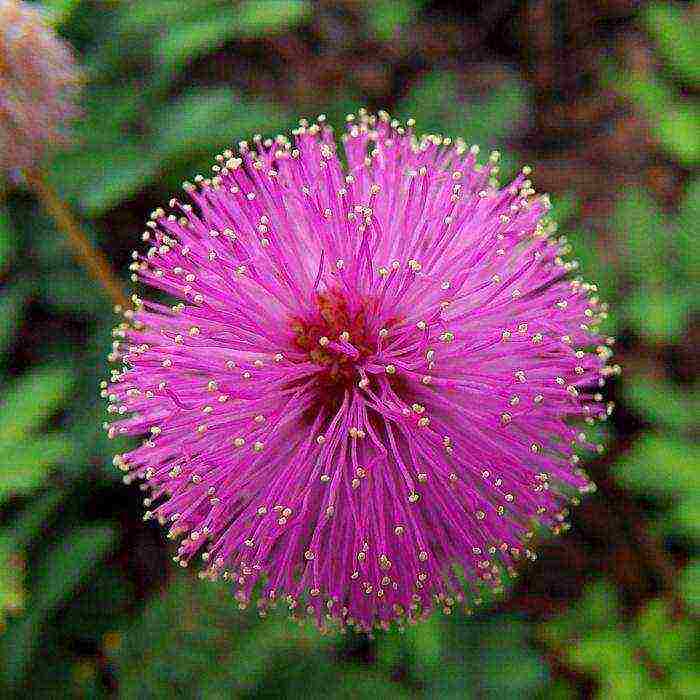
An interesting fact is the holding of the mimosa festival in France. This festival was first held in the province of Pierre-Riche at the beginning of the twentieth century. Nowadays it has not lost its importance. Numerous hills are covered with thickets of mimosa. Thousands of flowers emit a pleasant, rich aroma. Blooming mimosa in France means the end of winter and the beginning of spring. In honor of the holiday of flowers, parades are held throughout the country.


